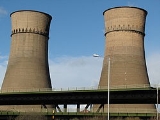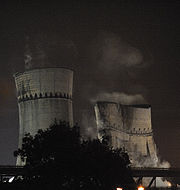
Blackburn Meadows Power Station
Encyclopedia
Blackburn Meadows Power Station was a coal-fired power station
situated on the River Don, between Sheffield
and Rotherham
. It is well known for its two iconic cooling tower
s which were demolished on 24 August 2008.
cooling towers 6 and 7 were constructed between 1937 and 1938, replacing earlier square cooling towers. They were designed by LG Mouchell and Partners. The station was nationalised after the Second World War and operated by the Central Electricity Generating Board. The station closed on 27 October 1980 with a generating capacity of 72 megawatts.
Most of the station was demolished following the closure, but two of the cooling towers were left standing until August 2008.
Part of the site is proposed to be used for a new biomass
power station
by the owners E.ON UK
.
 For safety reasons the Tinsley cooling towers could not easily be demolished, and were left standing unused for a further 27 years after the stations closure. Positioned directly alongside the major motorway bridge, Tinsley viaduct
For safety reasons the Tinsley cooling towers could not easily be demolished, and were left standing unused for a further 27 years after the stations closure. Positioned directly alongside the major motorway bridge, Tinsley viaduct
, the towers were an iconic landmark for the city, particularly due to their prominence when viewed from the M1 motorway
. There was a campaign to save the towers, known locally as the salt and pepper pots, from demolition with proposals to turn them into a giant art installation.
The two 250 ft (76.2 m) towers were demolished at 03.00 a.m. on 24 August 2008. However a significant portion of the north tower remained standing for a short while, which had to be destroyed manually.
Fossil fuel power plant
A fossil-fuel power station is a power station that burns fossil fuels such as coal, natural gas or petroleum to produce electricity. Central station fossil-fuel power plants are designed on a large scale for continuous operation...
situated on the River Don, between Sheffield
Sheffield
Sheffield is a city and metropolitan borough of South Yorkshire, England. Its name derives from the River Sheaf, which runs through the city. Historically a part of the West Riding of Yorkshire, and with some of its southern suburbs annexed from Derbyshire, the city has grown from its largely...
and Rotherham
Rotherham
Rotherham is a town in South Yorkshire, England. It lies on the River Don, at its confluence with the River Rother, between Sheffield and Doncaster. Rotherham, at from Sheffield City Centre, is surrounded by several smaller settlements, which together form the wider Metropolitan Borough of...
. It is well known for its two iconic cooling tower
Cooling tower
Cooling towers are heat removal devices used to transfer process waste heat to the atmosphere. Cooling towers may either use the evaporation of water to remove process heat and cool the working fluid to near the wet-bulb air temperature or in the case of closed circuit dry cooling towers rely...
s which were demolished on 24 August 2008.
History
The station was built in 1921 by the Sheffield Corporation, to support the steel industry in the Lower Don Valley. The station was expanded in the 1930s. HyperboloidHyperboloid structure
Hyperboloid structures are architectural structures designed with hyperboloid geometry. Often these are tall structures such as towers where the hyperboloid geometry's structural strength is used to support an object high off the ground, but hyperboloid geometry is also often used for decorative...
cooling towers 6 and 7 were constructed between 1937 and 1938, replacing earlier square cooling towers. They were designed by LG Mouchell and Partners. The station was nationalised after the Second World War and operated by the Central Electricity Generating Board. The station closed on 27 October 1980 with a generating capacity of 72 megawatts.
Most of the station was demolished following the closure, but two of the cooling towers were left standing until August 2008.
Part of the site is proposed to be used for a new biomass
Biomass
Biomass, as a renewable energy source, is biological material from living, or recently living organisms. As an energy source, biomass can either be used directly, or converted into other energy products such as biofuel....
power station
Power station
A power station is an industrial facility for the generation of electric energy....
by the owners E.ON UK
E.ON UK
E.ON UK is an energy company in the United Kingdom and a subsidiary of E.ON, the world's largest investor-owned power and gas company. As Powergen, it was listed on the London Stock Exchange and was once a constituent of the FTSE 100 Index but since 1 July 2002 has been owned by E.ON AG of...
.
Tinsley cooling towers

Tinsley Viaduct
Tinsley Viaduct is a two-tier road bridge in Sheffield, England; the first of its kind in the UK. It carries the M1 and the A631 1033 metres over the Don Valley, from Tinsley to Wincobank, also crossing the Sheffield Canal, the Midland Main Line and the former South Yorkshire Railway line from...
, the towers were an iconic landmark for the city, particularly due to their prominence when viewed from the M1 motorway
M1 motorway
The M1 is a north–south motorway in England primarily connecting London to Leeds, where it joins the A1 near Aberford. While the M1 is considered to be the first inter-urban motorway to be completed in the United Kingdom, the first road to be built to motorway standard in the country was the...
. There was a campaign to save the towers, known locally as the salt and pepper pots, from demolition with proposals to turn them into a giant art installation.
The two 250 ft (76.2 m) towers were demolished at 03.00 a.m. on 24 August 2008. However a significant portion of the north tower remained standing for a short while, which had to be destroyed manually.

